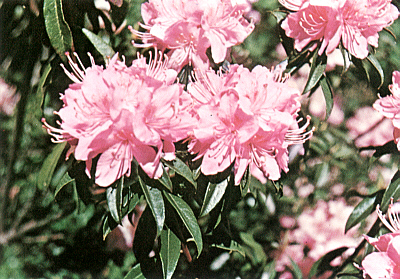R. davidsonianum 'Ruth Lyons'
Mrs. Ruth Lyons, Eugene, Oregon

|
|
R. davidsonianum
'Ruth Lyons'
Photo by Marshall Lyons |
When one talks or writes of rhododendrons being grown in the Northwest, the name James Barto invariably comes to mind. So it is with a
R. davidsonianum
'Ruth Lyons', a selected seedling from the Barto collection. For our newer Chapter members, James Barto acquired a homestead ten miles west of Junction City, in the Coast Range Mountains in 1920. Becoming interested in rhododendrons in 1925, he grew many rhododendrons from seed acquired from expeditions, rhododendron growers in this country, and from some of the British gardens. The expeditions of Kingdon-Ward, Sheriff, Forrest, Rock, Dr. Hu and others were sources of seed. Seedlings and layers of plants were traded with interested gardeners in this country and abroad.
About 1935, Mr. Lyons and I were browsing around the Barto place, looking at his many seedlings, when we were attracted to the row of
R. davidsonianums
which were in bloom. Mr. Lyons found a plant which had been broken off but had one small shoot with a single pink blossom. The plant was not for sale at the time. We made regular trips back to look for unusual things and kept a close watch on the little pink davidsonianum seedling. Later, we were able to obtain the plant. Placed in a choice location in our garden, it grew into a symmetrical, upright plant with vigorous growth habit.
The plant blooms profusely in April. The terminals have from ten to twelve clear, rich pink flowers, (rhodomine pink, H.C.C. 527/1-527/2) 1½ inches long and ¾ inch wide that do not fade. Some flowers have six petals. The leaf has a definite groove down the main rib and is quite stiff, about two inches in length. The plant grows vigorously and the leaf is more V shaped with possibly more substance than a regular davidsonianum. It blooms well in sun or shade but partial shade is ideal. Good drainage with plenty of humus is required.
Ruth Lyons isn't widely distributed, since it is not easy to propagate from cuttings. All our efforts to raise seedlings have resulted in plants of a lavender color. The plant is apparently hardy to zero.
This selected davidsonianum is one of the most admired plants in our garden and our pride and joy. In 1961 it received a PA and was named and registered as Ruth Lyons the same year.